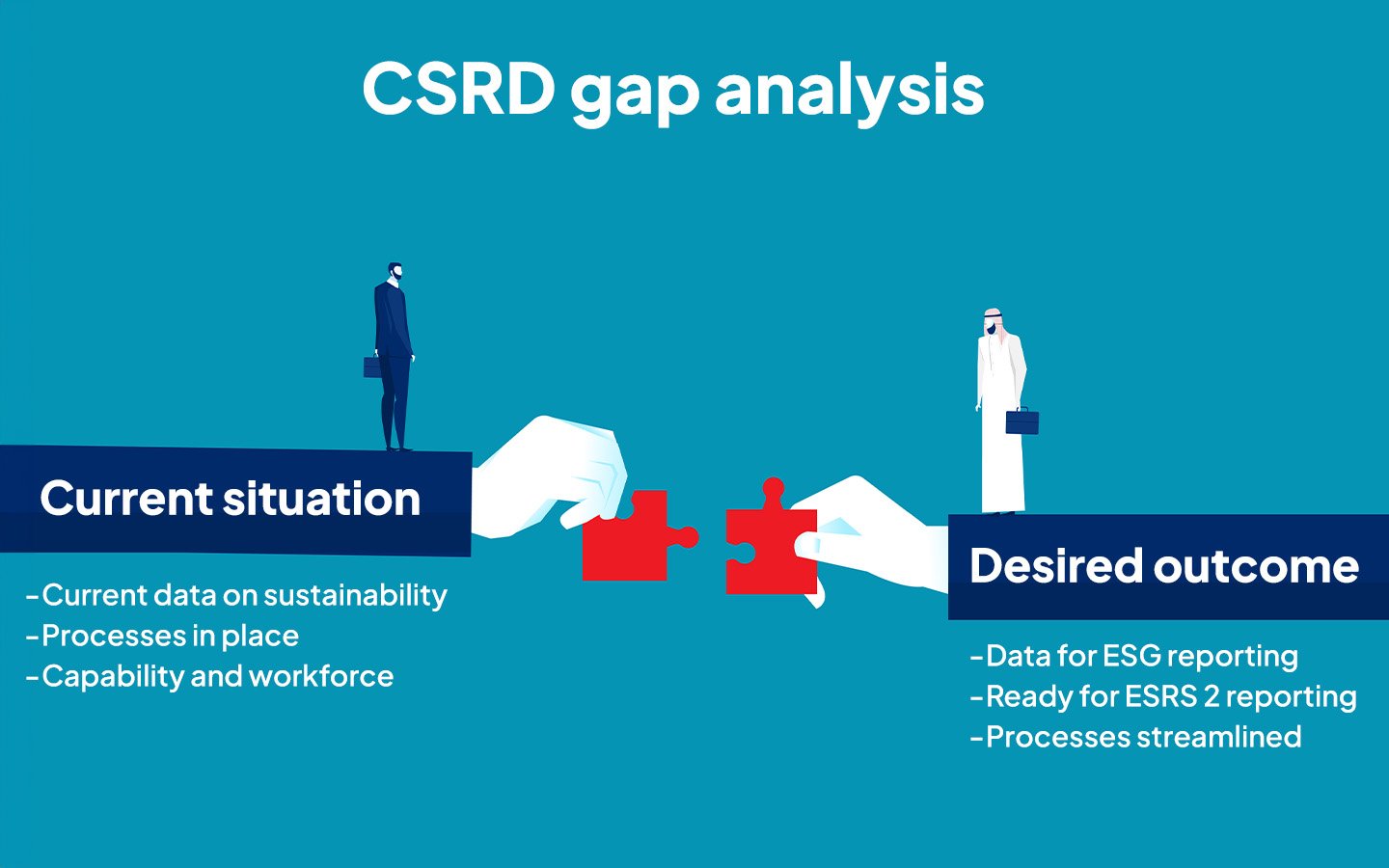What is a CSRD gap analysis?
A gap analysis for CSRD is a process that helps companies compare their current sustainability practices with the specific requirements of the CSRD. It identifies where they meet the standards and where there are gaps that need to be addressed.
By doing this, companies can focus on improving the areas that fall short and building on what they already have. This makes the process more efficient, cost-effective, and less time-consuming than starting from scratch.
A CSRD gap analysis can be a beneficial first step for companies aiming to comply with the CSRD. It serves as a strategic tool to pinpoint where current sustainability practices align with CSRD requirements and where improvements are needed.

Various types of gaps
When conducting a gap assessment in the context of the CSRD, it is essential not only to identify which gaps exist but also to determine what specific gaps need to be addressed. Effective gap assessment involves a deep understanding of the various layers where gaps can occur.
Broadly, there are three key layers to consider: data gaps, process gaps, and capability gaps. Each layer presents unique challenges that can affect an organization’s ability to produce accurate and compliant sustainability reports. By pinpointing what gaps to prioritize and address within each layer, organizations can more effectively close these gaps.
- Data gap: This occurs when the organization doesn’t have enough data or relevant metrics on a specific topic, making it difficult to provide accurate reports.
- Process gap: This gap arises when the systems or procedures for collecting, analyzing, and reporting data are not well-designed or efficient, leading to potential delays or inaccuracies.
- Capability gap: This happens when the organization lacks the necessary skills, tools, or expertise to effectively manage and utilize the data and processes, even if they are available and well-defined.
Alignment in the gap analysis
When conducting the gap analysis it’s crucial to evaluate not only where gaps exist but also how aligned current practices are with the required standards. Understanding alignment helps prioritize actions to close these gaps effectively.
Gaps can be classified based on their alignment into three categories. Each of these categories indicate a different level of readiness and the actions required to address them.
- Fully aligned: This indicates that current practices meet all the required standards. The necessary data, processes, and capabilities are all in place and functioning well, meaning no immediate action is required.
- Partially aligned: This suggests that while some aspects of current practices are sufficient, there are areas that need improvement. There might be data available, but it may be incomplete or not fully relevant.
- Not aligned: This indicates a significant gap where current practices are insufficient or nonexistent. The organization may lack critical data, effective processes, or the necessary capabilities altogether.
The preparation of the CSRD gap analysis
Conducting a CSRD gap analysis is crucial for identifying areas where additional reporting is required. In the section below, we will outline the essential steps to prepare for a detailed gap analysis for your CSRD.
Step 1: Know your desired outcome (Soll)
The first step in conducting a gap analysis for the CSRD is to clearly understand your future outcome. This involves identifying the specific requirements your organization must meet under the CSRD framework.
A crucial part of this process is determining which data you need to report on. To accurately assess this, you must conduct a double materiality assessment. This assessment helps to identify and prioritize the thematic topics that are most material to your company.
It’s important to note that every company is required to report on the CSRD ESRS 2, which covers the general requirements for sustainability reporting. Therefore, this standard is included by default in your future reporting obligations.
To do for this step:
Step 2: Know your current situation (Ist)
The next step in conducting a gap analysis for the CSRD is to thoroughly understand your current situation. The primary goal here is to identify which data you already have available. This process can be somewhat daunting, especially if your organization uses many software systems.
To streamline this process, it’s helpful to refer back to the desired outcomes you’ve already outlined. By aligning these with the data points within your existing systems, you can more easily identify relevant data that may already be collected.
Additionally, reviewing any previous sustainability reports and documentation your organization has produced can be incredibly valuable. These reports often contain a wealth of data that may be applicable to the CSRD requirements.
To do for this step:

Conducting an actual CSRD gap analysis
In the following section, you’ll learn how to perform a gap assessment for CSRD. The assessment involves three distinct layers to determine if a gap exists.
Step 1: Conduct a data gap assessment
After understanding your current situation, the next step is to perform a data gap analysis. This involves identifying gaps in the data required for CSRD compliance. To do this, you will compare the specific data needed for disclosure under each CSRD ESRS with the data you already have in place.
The goal of this step is to pinpoint specific gaps in your data collection and reporting processes. For example, you might discover that while you have some information on energy consumption, you lack comprehensive data on total energy usage. Similarly, you might identify gaps in data related to diversity rates within your workforce or information concerning the protection of whistleblowers.
By meticulously comparing required data points to your existing datasets, you can create a clear picture of where the gaps lie. This approach allows you to take targeted actions to fill these gaps.
To do for this step:
Step 2: Check if the processes are in place
Once you’ve identified data gaps, the next step is to perform a process gap analysis. This involves evaluating whether the necessary processes are in place to collect, manage, and report the required data for CSRD compliance.
A key part of this analysis is checking if your existing software tools are integrated correctly and whether they effectively capture and process the necessary data. You may also want to consider adopting specialized CSRD software that can serve as a centralized endpoint for all relevant data.
In addition to evaluating your software systems, it’s essential to assess whether your organization has the right policies and actions in place to support the reporting of specific data point. This might include reviewing your procedures for data collection, validation, and reporting.
To do for this step:
Step 3: Conduct a capability gap assessment
The final step in the gap analysis process is to conduct a capability gap assessment. This step involves evaluating whether your organization has the necessary capabilities to report on the required data points effectively. Specifically, you need to assess whether you have the right skills and teams in place to manage and report the data in compliance with the CSRD.
This assessment might involve reviewing the expertise of your current team, identifying any skill gaps, and determining whether additional training or recruitment is needed.
To do for this step:

Why is this analysis beneficial?
Conducting a CSRD gap analysis is especially beneficial for companies that have already engaged in sustainability reporting through other frameworks. Rather than starting from zero, these companies can leverage their previous work, streamlining their path to full compliance.
It is also advantageous for companies that have not yet gathered or reported sustainability data. For these companies, the CSRD gap analysis serves as a crucial starting point. It offers a structured approach to familiarize themselves with the essential data points required for compliance.
Improves data quality and consistency
By conducting a gap analysis, companies can assess and enhance their existing data collection and reporting processes. This leads to better data quality, consistency, and accuracy, which are critical for meeting the standards of the CSRD.
High-quality data enables companies to create more reliable and transparent sustainability reports, which can be used for internal decision-making and external communication. Furthermore, consistent data allows for year-over-year comparisons, helping companies to track progress, identify trends, and set more informed sustainability goals.
Supports strategic planning
The insights gained from a gap analysis provide valuable input for strategic planning. Companies can better understand where they need to focus their resources and efforts to improve their sustainability performance and reporting, aligning these efforts with their overall business strategy.
A thorough understanding of the gaps also allows companies to integrate sustainability more deeply into their core operations. This ensures that sustainability initiatives support long-term business objectives.
Addressing these gaps allows companies to better meet the growing demands of customers, investors, and other stakeholders who prioritize sustainability. This, in turn, enhances their competitive advantage in the market.
Prevents surprises later
A gap analysis helps organizations anticipate and address potential issues before they become critical. By identifying gaps early, companies can prevent unexpected challenges related to compliance, data integrity, or stakeholder expectations.
Additionally, it allows companies to stay ahead of any changes in regulatory requirements. The CSRD gap analysis gives time to adapt their processes and avoid surprises that could disrupt business operations or damage their reputation.





